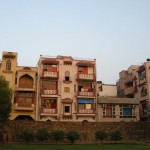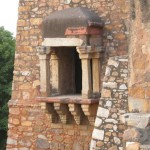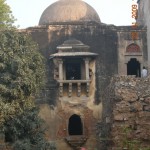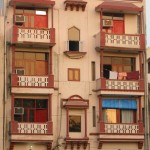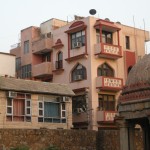Walking around monuments in Hauz Khas, 3 April 2010
The monuments’ complex in Hauz Khas village is a remarkable set of buildings in Delhi. It is a 14th century madrasa, an institution for Islamic learning, which is built around a 13th century tank. The heritage walk in Hauz Khas covers this madrasa complex as well as some monuments in the adjacent Deer Park. A winding lane from Hauz Khas village leads us to the gateway to the complex. There is a lot digging being done in the complex so most of the area is piled up with building materials and big stones. The madrasa building is built along one side of the tank and originally the water would have lapped its walls. Now the tank is much smaller and there is a landscaped park with jogging track between the tank and the madrasa. It is an excellent view of the surroundings and in the evening, with the birds chirping and colours of the sunset, it makes a beautiful setting. Walking through the pillared hallway, we reached Firuz Shah Tughluq’s tomb. There is minimal decoration on the façade but the interior of the dome is beautifully decorated. It is in urgent need for conservation as the surface now looks dark and mouldy. A little ahead is a pair of similar looking buildings along the boundary wall with would have been the original gateways for this complex. Firuz Shah’s tomb lay between the garden on one side and water on the other, a perfect setting for a royal tomb. The garden also has a number o f pavilions which are believed to be graves of those who served the madrasa as teachers or administrators. We now walked towards the Deer park. The largest building here is a Lodi period tomb called Bagh- I Alam ka gumbad. It too has a beautifully decorated ceiling. The exterior is plain with a bit of blue tile work and some marble and sandstone work. Nearby is a small tomb and wall mosque called Kali gumti. The final stop on the walk was Tuhfewala gumbad, a Tughluq period tomb with some striking cenotaphs.
- modern buildings outside madrasa complex
- jharokha on madrasa building
- another jharokha
These are pictures of apartments built just outside the madrasa complex. Note the jharokhas (the projecting windows) and the arches on the buildings. They almost replicate Firuz Shah’s architecture. Follies, that’s the word for them! In architecture, the word ‘folly’ is used light-heartedly to mean any structure which is new but is built to look like an old one. The use comes from Britain where canopies etc. were built in gardens primarily for decoration. In Delhi, Thomas Metcalfe’s follies are all around Mehrauli.
(posted by Rajesh Ranjan & Kanika Singh, team members, Delhi Heritage Walks)
